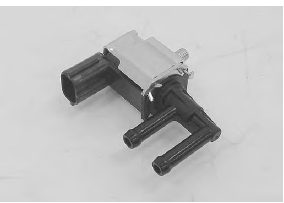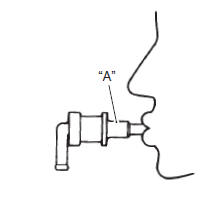Suzuki GSX-R 1000 Service Manual: Evaporative emission control system inspection (only for e-33)
Refer to “evaporative emission control system removal and installation (only for e-33)” .
Hose
Inspect the hoses for wear or damage. If it is worn or damage, replace the hose with a new one.
| Note make sure that the hoses are securely connected. |
Evap canister
Inspect the evap canister for damage to the body. If any defect is found, replace the evap canister with a new one.

Evap system purge control solenoid valve
| Note evap system purge control solenoid valve can be checked without removing it from the motorcycle. Refer to “dtc “c62” (p0443): evap system purge control solenoid valve circuit malfunction (e-33 only)” in section 1a . |
- Check that no air flows through both of the air inlet and outlet ports. If air flows out, replace the evap system purge control solenoid valve with a new one.

- Connect the 12 v battery to the terminals of the evap system purge control solenoid valve and check the air flow. If air flows out, the solenoid valve is in normal condition.

- Check the resistance between the terminals of the evap system purge control solenoid valve. If the resistance is not within the standard range, replace the evap system purge control solenoid valve with a new one.
Special tool
 (a): 09900–25008 (multi circuit
(a): 09900–25008 (multi circuit
tester set)
Tester knob indication resistance (Ω)
Evap system purge control solenoid valve resistance approx. 32 Ω at 20 °c (68 °f)

Fuel shut-off valve
 Gasoline Gasoline
and gasoline vapor is toxic. A small amount of fuel remains in the fuel shut-off valve when checking it. Do not swallow the fuel when blowing the fuel shut-off valve. |
- When air is blown into the fuel shut-off valve with its side “a” positioned upward, the air can pass through to the canister side.

- When air is blown into the fuel shut-off valve with its side “a” positioned sideways, the air cannot pass through to the canister side. If the fuel shut-off valve operates otherwise, it must be replaced.

 Evaporative emission control system
removal and installation (only for e-33)
Evaporative emission control system
removal and installation (only for e-33)
Hose
removal
Lift and support the fuel tank. Refer to “fuel tank
removal and installation” in section 1g (page 1g-
9).
Remove the frame cover assembly. Refer to “exterior parts remova ...
 Specifications
Specifications
Service data
Fi sensors
Tightening torque specifications
Reference: for the tightening torque of fastener not specified in this
section, refer to “tightening torque list” in section 0c . ...
Other materials:
Precautions
Precautions for exhaust system
To avoid
the risk of being burned, do not touch the exhaust system when the
system is hot. Any
service on the exhaust system should be performed when the system is
cool.
Caution
make sure that the exhaust pipes and muffler ...
Special tools and equipment
Special tool
...
Headlight
To replace the headlight bulbs,
perform the following steps:
Upper light bulb
Remove the bolt 1 to lift the
instrument panel 2.
Turn the cap 3 counterclockwise
and remove it.
Unhook the bulb holder spring
4 and pull out the socket 5.
Pull off the bulb from ...
